Western Asiatic Stamp Seal Collection
Lot 426
About Seller
TimeLine Auctions Limited
The Court House, 363 Main Road
Harwick, Essex CO12 4DN
United Kingdom
Estimate:
GBP£800 - GBP£1,000
$1,081.08 - $1,351.35
Absentee vs Live bid
Two ways to bid:
- Leave a max absentee bid and the platform will bid on your behalf up to your maximum bid during the live auction.
- Bid live during the auction and your bids will be submitted real-time to the auctioneer.
Bid Increments
| Price | Bid Increment |
|---|---|
| GBP£0 | GBP£5 |
| GBP£100 | GBP£10 |
| GBP£200 | GBP£20 |
| GBP£500 | GBP£50 |
| GBP£1,000 | GBP£100 |
| GBP£2,000 | GBP£200 |
| GBP£5,000 | GBP£500 |
| GBP£10,000 | GBP£1,000 |
| GBP£20,000 | GBP£2,000 |
| GBP£50,000 | GBP£5,000 |
| GBP£100,000 | GBP£10,000 |
| GBP£250,000 | GBP£20,000 |
About Auction
By TimeLine Auctions Limited
Nov 23, 2018
Set Reminder
2018-11-23 05:00:00
2018-11-23 05:00:00
America/New_York
Bidsquare
Bidsquare : TimeLine Auctions London Mayfair Sale
https://www.bidsquare.com/auctions/timeline-auctions-limited/timeline-auctions-london-mayfair-sale-3572
Auction Venue: The May Fair Hotel London Stratton Street Mayfair London, W1J 8LT Viewing from noon Thursday 22nd Nov. 2018 Champagne Reception: 6pm - 9pm Friday 23rd Nov. 2018 (Day 1) 10am : Lots 1 - 660 TimeLine Auctions Limited enquiries@timelineauctions.com
Auction Venue: The May Fair Hotel London Stratton Street Mayfair London, W1J 8LT Viewing from noon Thursday 22nd Nov. 2018 Champagne Reception: 6pm - 9pm Friday 23rd Nov. 2018 (Day 1) 10am : Lots 1 - 660 TimeLine Auctions Limited enquiries@timelineauctions.com
- Lot Description
3rd-1st millennium BC. A group of ten stamp seals, including two accompanied by typed and signed notes by the late W.G. Lambert, Professor of Assyriology at the University of Birmingham 1970-1993, which state: (R 439) 'Stamp Seal of Black Stone, 23 x 23 x 16mm. This is square with a flat face, and the back which rises first with grooved vertical sides, then flares inwards to a pierced handle with linear decoration on the top. The design shows a standing horned quadruped suckling its young, and tête bêche another standing quadruped of a different type. This comes from Syria and dates to c. 900-600 B.C. It is in very good state of preservation.'; (R-785) 'Stamp Seal of Black Stone, 17 x 16 x 13mm. This has a roughly square flat face, and short sides that rise steeply with upper bevelled edge to the base of a stout pierced loop. The design, which is put within a linear frame, consists of a prancing horned quadruped with branch rising from its back and sideways twig between its legs. This comes from Syria-Palestine and dates to c. 1000-700 B.C. it is a little chipped at one corner, but is generally in good condition.'; the rest comprising: three square-shaped, four oblong shaped seals with geometric designs; and one square seal with two simple horned animals, possibly bulls, each with long curved tail. 145 grams total, 17-44mm (1/2-1 3/42"). The Signo collection, the property of a West London businessman, formed in the late 1980s-early 1990s; collection numbers K-24, R-439, R-785, V-426, W-204, W-836, W-856, X-76, X-79, Z-63, academically researched and catalogued by the late Professor Lambert in the early 1990s. Dr. Bonewitz notes: 'The seals are made from limestone (4), serpentine (4), jasper (1), and bone (1).' [10]Fine condition.
Condition
- Shipping Info
-
Buyer Pays Shipping Costs
-
- Buyer's Premium



 EUR
EUR CAD
CAD AUD
AUD GBP
GBP MXN
MXN HKD
HKD CNY
CNY MYR
MYR SEK
SEK SGD
SGD CHF
CHF THB
THB











